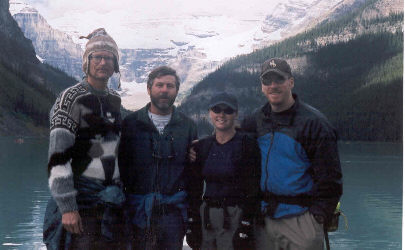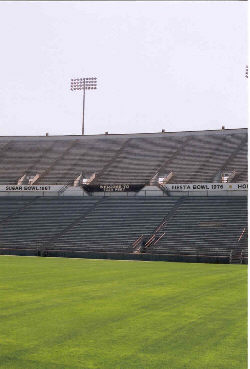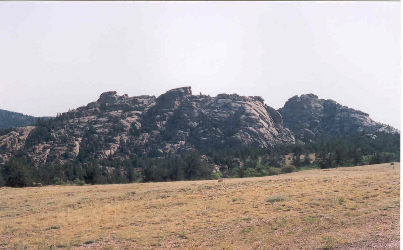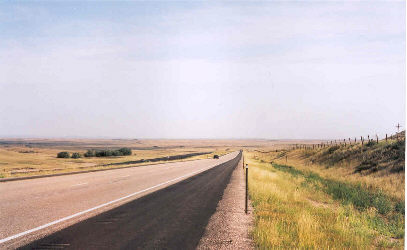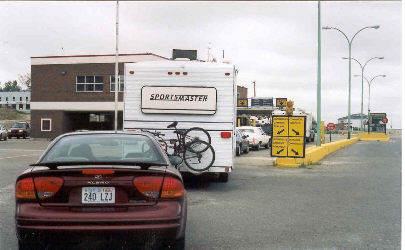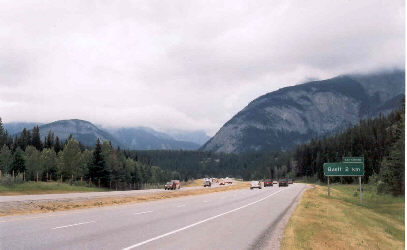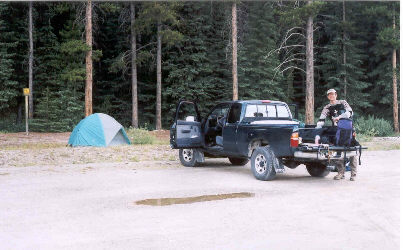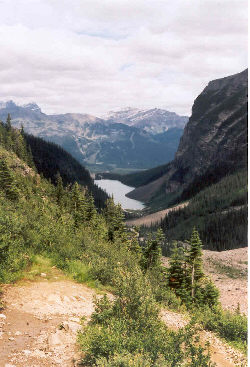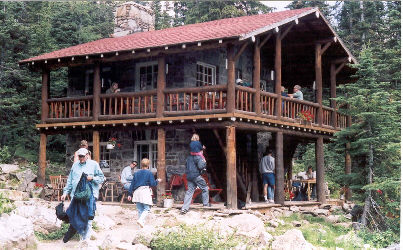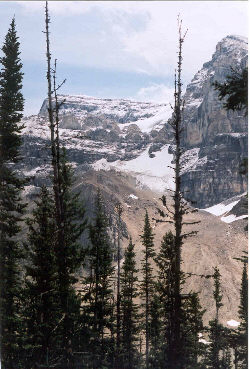|
||||||||||||||||||
|---|---|---|---|---|---|---|---|---|---|---|---|---|---|---|---|---|---|---|
Banff Assiniboine Expedition I
|
|
Stadium steps are bad enough and even worse at 7200 feet |
After the finish of our trip to Bolivia, Anne and Jim headed back to California and Guam respectively, while Gary and I were back in Cheyenne for the coming cold weather climbing season. The mountains of Colorado had a sparse snow year but we were still able to keep up our skills with winter climbs of Mt. Shavano, Medicine Bow Peak, and Flattop Mountain and later spring climbing on Torreys Peak and the South Maroon Bell. I also made an effort to stay in shape on the University’s stadium steps, which at elevation 7200 feet, have got to be about the highest in the land. Jim meanwhile kept pace in the warm climate of Guam, paddling offshore and training for and competing in an adventure race on the island . . . not quite snow, but come on . . . he lives on Guam.
Planning for some sort of expedition began in early 2002 and Gary and I soon put out the word, we were heading north in mid summer. Diana and Jim “signed on” and an “expedition” was born. We started researching peaks and finally chose what we hoped would be a well rounded selection of climbs, ranging in difficulty from Class I to Class IV and including either Mt. Robson or Mt. Assiniboine in the mix. For those unfamiliar with Robson, it is a classic North American mountaineering challenge whose ability to make its own weather can put folks on the summit with a moderate effort or preclude a season’s worth of climbers from a summit opportunity. On the other hand, Mt. Assiniboine is the “Matterhorn” of the Canadian Rockies, a beautiful peak with some technical rock climbing required to reach the top.
|
Veedavoo climbing area, between Cheyenne and Laramie, Wyoming |
Just before leaving, we spent a day at the local rock climbing area and practiced the skills learned in Bolivia the previous summer that would be needed to complete the Canada trip safely. We practiced placing rock protection in the event we decided to take a shot at Mt. Assiniboine as well as rope coils and the knots needed for the roped glacier travel. Most importantly, we each constructed a z-pulley crevasse haulage system to ensure that we could individually assemble the mechanism needed to extract a disabled climber from a crevasse. After a full day of practice, we were ready for the final step – packing. Gary and I finalized gear lists, purchased miscellaneous items, and declared ourselves ready.
Meanwhile, Jim headed for the mainland, sending me an email on the 30th advising of his transit through Narita. He would spend time visiting family in Salt Lake and then fly to Calgary for an airport rendezvous on the morning of August 4.
August 2, 2002 – Day 1, Heading North
|
There is a lot of this between Cheyenne and Calgary! |
We headed north in separate vehicles planning to meet in Calgary on the evening of the August 3. The route from Cheyenne to Calgary is mostly fast interstate and even the state routes in Montana are clear 70 mph runs. We both headed north to Billings, missed the same cut off to Montana Rte 3 and ended up going out I-90 to Big Timber (adding about 45 miles to the trip) before cutting north toward Great Falls. I was about an hour and a half ahead of Gary and Diana and subsequently missed the downpours that made their trip a hydroplaning experience. My first day closed at the Great Falls KOA after a 600 mile run that included Wyoming and all but the last hundred miles of the drive through Montana. I also noticed that the air had a bit more of chill than the sweltering days we had been experiencing all summer in Cheyenne. Was something up?
August 3, 2002 – Day 2, Arrival in Calgary
I broke camp early and headed north for the border and Calgary. The crossing was uneventful and I stopped for lunch in Lethbridge before closing the second day’s 400-mile trip at the KOA near the Olympic Park on the western edge of Calgary. Gary and Dianna arrived at about 5 p.m. in a seriously loud (Dodge diesel) rental RV that they would use for lodging for the remainder of the trip. Jim and I meanwhile planned to go the tent route and join the others for meals in the camper.
|
100 yards to Canada |
Everyone but Jim was now in Calgary but the weather was not what we expected. Statistically, the later part of July and early August should be beautiful summer weather, warm days and little rain, followed by a distinct turn for the worst (rain and cold) toward the end of August. We had planned to catch the tail end of the good spell but instead we were sitting in the RV while the clouds hung barely off the ground and the rain steadily fell. Unbeknownst to us, the summer weather was not sticking with the normal pattern and just the day before, Banff and the western ‘burbs of Calgary had seen snow. Moreover . . . the forecast was not looking up for the rest of the week.
Regardless of rain, there were things to do. We headed into town for dinner and then did the grocery shopping for the first half of the trip. You know the lines . . . “will you eat this, what about these, Froot Loops or Cherios?” I think we had 14 of the standard issue shopping bags – nobody was going to go hungry on this trip.
August 4, 2002 – Day 3, Arrival in Lake Louise
|
Road heading to Lake Louise, the sky isn't looking good for climbing |
On Sunday, we again split the group, the RV heading to Lake Louise early to get a camp spot in one of the first come/first serve Banff Park campgrounds and me to the airport to pick up Jim. Jim’s flight from Salt Lake was on time and soon enough we were heading west to pick up his rental gear in Canmore, just shy of Banff.
Due to Jim’s residence on Guam and the spare alpine climbing conditions he experiences there, I made arrangements to rent double plastic boots, an alpine axe, climbing harness and helmet in Canmore. This was no small trick as Jim has size 14 feet and one does not find many rental boots that large. Fortunately, this outfit did have one pair and we gave them a deposit a few weeks before the trip to make sure the boots were there when we walked through the door. Gear in hand, we next found some lunch before getting back on the Trans Canada to finish our day in Lake Louise.
|
Chateau Gravel Pit, pale in comparison to the one at the edge of Lake Louise |
We found Gary and Diana in the campground but also found that no tent camping was permitted due to a grizzly bear making regular rounds through the camp area. The result was a ban on tents and soft-sided RV’s, Gary and Diana were OK but it looked like we were not going to be camping in the same area. Fortunately, the “overflow” campground for the Lake Louise area was still OK for tenting so Jim and headed off to find the gravel pit, five miles distant, that would be our home for the next couple of days.
That evening, we also put together the plan for the next day, a climb of Mount Aberdeen via the normal glacier route with a climb of Mount Haddo from the connecting col if the weather would cooperate. We located the trailhead at Lake Louise and all was set for a climb beginning with a four a.m. alpine start. We knew from a conversation with a park ranger at the visitor center that Aberdeen would be a long day. We also learned our first euphamism of Park officialdom, when the ranger says a climb is “a good day” that means 14 hours with an alpine start. By the end of the trip, we had learned that all day trips in the Canadian Rockies tend toward a bit on the longer side.
August 5, 2002 – Day 4, Consolation Hike to the Plain of Seven Glaciers Tea House
|
Looking back toward Lake Louise, we're almost to the tea house. |
The alarm went off all too early at three a.m. but with all its buzzing, it paled in comparison to the sound of the steady rain hitting the tent. I reset the alarm to four and figured a bit of a late start would be better than a soaked start. Four o’clock came but the continued steady rain led me only to ponder if I should make an effort to contact Gary with regard to our complete lack of enthusiasm to start moving toward the trailhead. I did not make the effort, figuring that the rain was sending him the same message and our failure to appear a second time would leave him with little doubt.
|
Plain of Six Glaciers teahouse |
The rain finally let up a bit after seven so Jim and I headed over to the other campground to join in some sort of a plan for the day. We ate breakfast and I suggested a hike to the teahouse located on the Plain of Six Glaciers, well past and above the far end of Lake Louise. This hike would not only kill time but also take us past the flank of Mounts Haddo and Aberdeen and hopefully give us the opportunity to see at least a portion of the glacier route now planned for the following day.
|
View of Aberdeen Glacier from teahouse. Aberdeen Glacier straddles the col between Mts. Haddo and Aberdeen |
We joined the tourist horde at the lake parking lot and under a steadily improving sky, hiked the 3-½ miles along the lake and up to the teahouse. For those unfamiliar with Lake Louise and this area of the Canadian Rockies, climbing and alpine hikes have been popular there for well over one hundred years. The climbing scene began with the importation of Swiss mountain guides by the Canadian Pacific Railroad before the turn of the last century and a high hut and two teahouses are located around the Lake Louise high country. The Seven Glaciers teahouse served tea, cakes, and sandwiches and provided a good view of the peaks that make up the cirque at the far end of the lake. Not only could we see a portion of the Mount Aberdeen route we planned to climb the next day, but also routes on Mts. Lefroy and Victoria.
We did the tea routine and then headed back to a light dinner and our respective camps. Enroute, the slopes of Mts. Lefroy and Victoria reminded us with the sight and sound of falling serac avalanches that we were “not in Kansas anymore” and that the ante for the climbs to come were going to be a bit higher than a summertime climb in Colorado.

